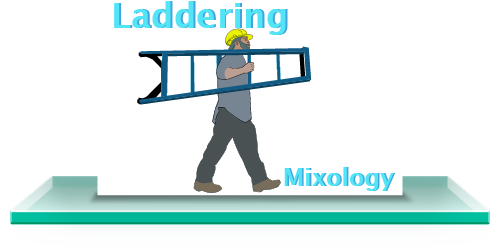The Laddering Technique takes an initial (specific) idea and then forms ladder-rungs of connections that lead away into different aspects of this initial idea.
Laddering is a way of establishing a diverse framework from which general creative ideas can be imagined.
 How does 'Laddering' Work?
How does 'Laddering' Work?
The Chains creative technique identifies chains of creative ideas that are useful in the production of a creative work because they relate to the specific (starting) idea on which creative work is based.
Laddering starts with the specific ideas being analysed and then forms ladder rungs of connecting ideas that climb out of the specific idea.
Each creative ladder is made up of a line of rungs - where each rung is a connected idea - and where each rung represents a progression along a chosen path.
Laddering is listed as a Mixology Technique as it is highly effective when used to generate general creative ideas, each step of each separate ladder being a creative provocation in its own right.
 Illustration: Laddering
Illustration: Laddering
The following shows how the Laddering Creative Technique has been used in the construction of The Tailor.
In this illustration the Laddering Technique is used to develop a framework of themes, concepts and ideas that ladders-out from the chosen subject matter (i.e. chosen specific ideas).
- Listening: Anjali explores and develops a new tailoring service.
- Experiment: The process and consequence of establishing this service.
- Conviction: The state of mind that overcomes initial setbacks.
- Learning: The adaptations that lead to renewed progress.
The Specific Ideas that outline the narrative passages in development:
The following ladders consisting of advancing ladder rungs that define a framework of themes, concepts and ideas are built outwards from the specific ideas listed above.




The following are examples of passages from The Tailor that were derived from the concepts listed in the above ladder rungs:
Ladder: Listening
Anjali grasped quickly that her early customers must be comfortable with the need to get to the bottom of things with haste. The client required an interest in - and preferably a love of - clothing as well as at least some understanding of a garment's intrinsic role in how others see us. This much she had identified during the sleepless nights that are the sure bedfellows of a tailor pondering a 'possible opportunity, but potential distraction.'
Ladder: Experiment
The 'alterations consulting room' consumed a large measure of coffee and fashionable biscuits but delivered little beyond the snaring of some extra alteration work, for which the profit was so thin it was see-through. The theory of 'fashion through progressive alteration' seemed to be an illusion and perhaps even a delusion. There were soon tensions twisting between the two business partners, which threatened to tear open the seams of 'Threads of Arrow Street'
Ladder: Conviction
It was no surprise to either of the women running 'Threads of Arrow Street' that, as in life so in fashion, everything is a struggle; and what works today would not have worked yesterday and could never have worked tomorrow. The muddled and muddy river of circumstance flows freely and never freezes, and all you can do is pick your moment and leap into the dark.
Ladder: Learning
There is an acceptance that 'things that look as they should, most probably will function as they should.' This rule is as applicable to the design of any garment, as it is to the feeling of a tailor's consulting room. Anjali's cluttered consulting room, like any good garment, was designed to an idea, but soon wore into an exact and comfortable fit.

